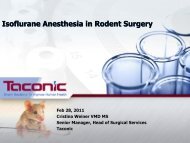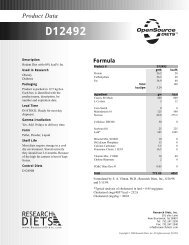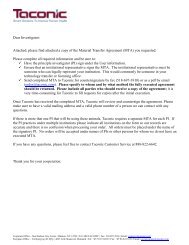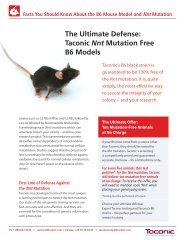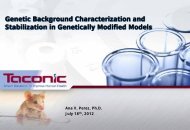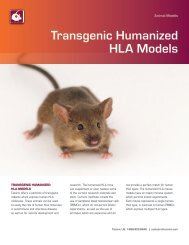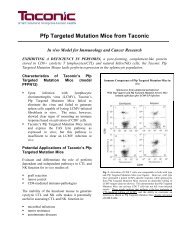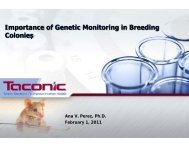Sprague Dawley® Rat Model - Taconic
Sprague Dawley® Rat Model - Taconic
Sprague Dawley® Rat Model - Taconic
Create successful ePaper yourself
Turn your PDF publications into a flip-book with our unique Google optimized e-Paper software.
<strong>Sprague</strong> <strong>Dawley®</strong> <strong>Rat</strong><br />
The most widely used outbred rat model for research, the<br />
<strong>Sprague</strong> Dawley ® is ideal for applications requiring accurate<br />
estimation of gestational age.<br />
The excellent reproductive performance of the <strong>Sprague</strong> Dawley ® model makes it a<br />
preferred choice for generating timed-pregnant females. <strong>Taconic</strong>’s proven process for<br />
producing this model ensures timed-pregnant rats bearing litters within a 24-hour<br />
window of gestational age.<br />
Options Available:<br />
The preferred choice<br />
for generating timedpregnant<br />
females.<br />
This booklet presents abridged descriptions. For additional information on model origins and pricing as well as<br />
model datasheets and references, please see the <strong>Taconic</strong> website at www.taconic.com.<br />
US: 1-888-822-6642 • custserv@taconic.com | Europe: +45 70 23 04 05 • taconiceurope@taconic.com
<strong>Sprague</strong> Dawley ® <strong>Rat</strong> <strong>Model</strong><br />
The <strong>Sprague</strong> Dawley ® outbred model was developed<br />
by R. Dawley, <strong>Sprague</strong>-Dawley Company, Madison,<br />
Wisconsin, in 1925. NIH received stock in 1945<br />
and <strong>Taconic</strong> later received stock from the NIH<br />
Animal Genetic Resource in 1970. Refreshed with<br />
NIH Genetic Resource stock in 1998, the rats are<br />
maintained by rotational breeding in a closed colony.<br />
Nomenclature: NTac:SD<br />
Characteristics<br />
• Most widely used outbred rat in biomedical<br />
research<br />
• Excellent reproductive performance,<br />
making it an ideal model for generating<br />
timed-pregnant females<br />
• Docile nature<br />
• Coat Color: Albino<br />
• Coat color loci: Tyr c<br />
<strong>Sprague</strong> Dawley ® One Year Growth<br />
6 7 8 9 10 11 12 13 14 15 16 17 18 22 26 30 34 38 42 46 50 54 58<br />
Research Applications<br />
• Toxicology, safety & efficacy testing,<br />
reproduction and development,<br />
behavior, aging, teratology, oncology,<br />
nutrition, and pharmacology studies<br />
• Study of maternal and fetal<br />
infection (Riggs)<br />
• Study of the effects of pre-natal<br />
high-salt diet on offspring<br />
(Porter)<br />
• Study of the effects of sex and<br />
hormonal status on restraint-<br />
stress-induced working memory<br />
impairment (Shansky)<br />
• Study of bone-specific<br />
osteocalcin gene in mouse and<br />
rat (Rahman)<br />
• Study of hippocampal excitability<br />
during the estrous cycle in<br />
rats (Scharfman)<br />
US: 1-888-822-6642 • custserv@taconic.com | Europe: +45 70 23 04 05 • taconiceurope@taconic.com<br />
700<br />
600<br />
500<br />
400<br />
300<br />
200<br />
100<br />
0
<strong>Sprague</strong> Dawley ® Physiological Data<br />
Parameter Units SD Males SD Females<br />
Serum Chemistry Avg±D.D.<br />
Glucose mg/dL 82.4 ± 11.3 93.2 ± 10.3<br />
Creatinine mg/dL 0.3 ± 0.1 0.3 ± 0.1<br />
BUN mg/dL 9.1 ± 1.4 13.6 ± 3.0<br />
Total Bilirubin mg/dL 0.1 ± 0.0 0.1 ± 0.0<br />
Total Protein<br />
Blood Counts<br />
Erythron<br />
g/dL 6.4 ± 0.2 6.7 ± 0.2<br />
Red Blood Cells x106 /µL 6.9 ± 0.3 7.7 ± 0.3<br />
Nucleated RBC x106 /µL 0 0<br />
Hemoglobin g/dL 14.5 ± 0.8 16.1 ± 0.6<br />
Hematocrit % 48.3 ± 2.3 51.2 ± 2.6<br />
MCV fL 69.9 ± 1.7 66.9 ± 0.9<br />
MCH pG 20.9 ± 1.3 21.0 ± 1.1<br />
MCHC<br />
Platelets<br />
% 29.9 ± 1.6 31.4 ± 1.9<br />
Platelets x103 Leukogram<br />
/µL 1358.0 ± 123.8 1262.2 ± 278.4<br />
White Blood Cells x103 /µL 9.4 ± 3.2 6.0 ± 1.5<br />
Neutrophil x103 /µL 0.9 ± 0.5 0.4 ± 0.3<br />
Bands x103 /µL 0 0<br />
Lymphocyte x103 /µL 8.3 ± 2.9 5.5 ± 1.4<br />
Monocytes x103 Urinalysis<br />
/µL 0.3 ± 0.3 0.1 ± 0.1<br />
Glucose mg/dL Negative Negative<br />
Blood Negative Negative<br />
pH 6.75 ± 0.35 6.7 ± 0.4<br />
Protein mg/dL N/A N/A<br />
Specific Gravity 1.0195 ± 0.0068 1.0155 ± 0.0079<br />
Life Span 24 - 36 Months<br />
Food Consumption 4-5g/100g Body Weight<br />
Water Consumption 8-11ml/100g Body Weight<br />
Additional Data n=10<br />
Available at taconic.com/SD<br />
There are three health<br />
standard options available<br />
for <strong>Sprague</strong> Dawley ® :<br />
• Murine Pathogen Free<br />
• Restricted Flora<br />
• Germfree<br />
US: 1-888-822-6642 • custserv@taconic.com | Europe: +45 70 23 04 05 • taconiceurope@taconic.com<br />
<strong>Sprague</strong> Dawley ® <strong>Rat</strong> <strong>Model</strong><br />
Flexible Health<br />
Standard Options<br />
<strong>Taconic</strong> offers the <strong>Sprague</strong> Dawley ® model<br />
at a variety of health profiles, enabling you<br />
to choose a profile that suits the needs of<br />
your specific research project and facility.<br />
Transportation methods for all models are<br />
designed to ensure the integrity and safety of<br />
your animals during shipment.<br />
<strong>Rat</strong>s bred to the Restricted Flora TM (RF)<br />
health standard and Murine Pathogen Free TM<br />
(MPF) health standard are shipped in our<br />
unique <strong>Taconic</strong> Transit CageTM . <strong>Taconic</strong> is<br />
the only commercial supplier of the <strong>Sprague</strong><br />
Dawley ® model at the Germfree (GF) health<br />
standard, delivered in our Germ-Free<br />
Shippers. Regardless of the health standard<br />
selected, <strong>Taconic</strong> <strong>Sprague</strong> Dawley ® rats<br />
provide 95% or greater accuracy on timedpregnant<br />
gestation.
<strong>Sprague</strong> Dawley ® <strong>Rat</strong> <strong>Model</strong><br />
The Role of Timed-Pregnant<br />
<strong>Sprague</strong> Dawley ® <strong>Rat</strong>s in<br />
Biomedical Research<br />
The ability to monitor embryonic development and<br />
accurately determine gestational age of lab animal<br />
embryos is vital in many areas of biomedical research.<br />
For this reason, embryos of timed-pregnant <strong>Sprague</strong>-<br />
Dawley rats are used in the study of embryonic<br />
development, teratology and reproductive toxicology, as<br />
well as experiments using fetal tissue that requires cell<br />
harvesting and culturing at specific embryonic ages.<br />
Critical investigations by R.J. Blandau and his colleagues<br />
more than 50 years ago established procedures<br />
for measuring and timing gestational development<br />
in rats with high accuracy. Monitoring gestational<br />
development requires a reliable determination of the<br />
time of conception. Since no scientific method exists<br />
to determine the exact time of conception, indirect<br />
indicators are used. Vaginal swabs can confirm male<br />
fertility and offer a quantitative indicator of the likelihood<br />
of fertilization, making the presence of sperm in the<br />
vagina of female rats in estrus a reliable indicator<br />
of conception.<br />
The female rat accepts the male for mating only at the<br />
end of the 12-hour preliminary period of proestrus and<br />
during the 12 hours of estrus. Ovulation occurs about<br />
10 hours after the onset of estrus. Sperm migrate<br />
from the uterus to the oviduct about 15 minutes after<br />
copulation; at one hour, sperm are found throughout<br />
the oviduct and at three hours, 90% of the ova are<br />
fertilized. Based on this data, using proper monitoring<br />
and controls, the onset of embryonic development can<br />
be estimated with considerable accuracy.<br />
US: 1-888-822-6642 • custserv@taconic.com | Europe: +45 70 23 04 05 • taconiceurope@taconic.com<br />
Gestational age is measured from the time of<br />
conception, which marks the beginning of embryonic<br />
Day 1. At 24 hours after conception, as Day 2 begins,<br />
the embryo has cleaved or is about to cleave into the<br />
two-cell stage. At the beginning of Day 4, the embryo –<br />
a morula that contains 12 to 16 cells – begins to enter<br />
the uterus. Implantation usually begins on the evening of<br />
Day 5 as the embryo settles into the maternal uterine<br />
wall. Implantation occurs when the blastocyst, or<br />
germinal vesicle, becomes clasped by the endometrium;<br />
the blastocyst orients itself with the inner cell mass<br />
facing the underlying maternal tissue. Estrogen and<br />
other hormonal conditions in the uterus affect the rate<br />
of development at implantation.<br />
During Day 6, the blastocyst increases in size and<br />
elongates. Implantation sites are visually evident by<br />
Day 7. During Days 9 and 10, the beginning of somite<br />
formation takes place. Somites – segments formed on<br />
either side of the embryo’s neural tube – develop into<br />
external body forms as they transform into muscle<br />
mass connected to a spinal nerve. The number of<br />
somites increases at a known progression, which can<br />
be used to track development.<br />
The organogenesis stage begins at Day 5 and continues<br />
for 8 or 9 days. During this period rudimentary<br />
organs, or anlagen, appear. The anlagen undergo<br />
cellular growth, with development branching off or<br />
differentiating toward unique organs and an adult organ<br />
morphology achieved. This is the period of greatest<br />
susceptibility to carcinogens or teratogens, which cause<br />
fetal tumors, malformations or disruption of the normal<br />
development rate.
Following organogenesis, the embryo enters the stage<br />
of maturation, the time when organs grow and become<br />
functionally complete. By Day 15 the embryo’s head<br />
is growing faster than the rump; the previously pearshaped<br />
body evolves into a cylindrical shape; the eyelids<br />
are formed and fused. The bones develop joint cavities<br />
over several days of maturing development. The joint<br />
cavities develop for the shoulder, elbow, hip, and knee<br />
joints during Day 16, the carpal and tarsal joints on Day<br />
17, and the digital joints of the legs during Day 19 or<br />
20. By Day 22, blood-forming activity in the liver nearly<br />
ceases with the end of gestation. Since the gestation<br />
period is 21 to 23 days, Day 22 is the average date<br />
of birth.<br />
Another measure of gestational age is embryo crown-torump-length,<br />
for which standard rates of development<br />
are well documented. The crown-to-rump measurement<br />
is taken from the vertex to the rump, taking care to<br />
45<br />
40<br />
35<br />
30<br />
25<br />
20<br />
15<br />
10<br />
5<br />
0<br />
US: 1-888-822-6642 • custserv@taconic.com | Europe: +45 70 23 04 05 • taconiceurope@taconic.com<br />
<strong>Sprague</strong> Dawley ® <strong>Rat</strong> <strong>Model</strong><br />
Fetal Crown-to-Rump Lengths<br />
avoid caliper pressure that would distort the natural<br />
curvature of the embryo. At Day 11, there are 4 to 13<br />
somites and the average crown-to-rump length is 2.00<br />
mm. By Day 16, there are 58 to 65 somites and the<br />
crown-to-rump length is about 13.5 mm. At Day 22<br />
– the average date of birth – the crown-to-rump length<br />
ranges from 40.5 to 42.6 mm and the weight of the<br />
neonate is 5.9 to 6.4 grams.<br />
Many factors influence the rate of embryo development,<br />
including the light-dark cycle that affects the onset of<br />
ovulation, the initial position of the embryo in the genital<br />
tract, the hormonal variables of the mother, litter size,<br />
maternal diet and environmental conditions. During<br />
the complex processes of development, toxicological<br />
and environmental factors also can affect the rate of<br />
development. As a result, the actual rate of embryo<br />
development can vary from the nominal gestational age.<br />
11 12 13 14 15 16 17 18 19 20 21 22<br />
Days In Gestation
<strong>Sprague</strong> Dawley ® <strong>Rat</strong> <strong>Model</strong><br />
Production of Timed-Pregnant<br />
<strong>Sprague</strong> Dawley ® <strong>Rat</strong>s at <strong>Taconic</strong><br />
<strong>Taconic</strong> breeding specialists use proven, highly effective<br />
procedures to produce timed-pregnant <strong>Sprague</strong>-<br />
Dawley ® rats. While gestational age cannot be<br />
determined with total precision, strict adherence to<br />
pre-defined mating procedures and close monitoring<br />
of female rats after they are co-housed with males can<br />
define with accuracy the 24-hour period during which<br />
mating and presumably conception occurs.<br />
At <strong>Taconic</strong>, the day of sperm cell detection in females<br />
is called the sperm-positive date and is considered<br />
Day 1 of gestation. After setup the prior day, animal<br />
care technicians take vaginal swabs of females cohoused<br />
with males between 7 and 10 a.m. daily. This<br />
procedure assumes that timed-pregnant females have<br />
mated and conception has occurred from 0 to 24 hours<br />
before the designated sperm-positive date. Presumably,<br />
the majority mate around the midpoint of the previous<br />
day’s dark cycle, from 6 p.m. to 6 a.m.<br />
When investigators order timed-pregnant rats at a<br />
specified developmental age for delivery on a specific<br />
date, <strong>Taconic</strong> technicians select rats based on the<br />
sperm-positive date. For instance, for an order for<br />
rats bearing embryos at Day 15 of gestational age<br />
for delivery on January 15, <strong>Taconic</strong> would select<br />
timed-pregnant females with a sperm-positive date of<br />
January 1. To avoid confusion over conflicting<br />
conventions for defining gestational age,<br />
<strong>Taconic</strong> advises investigators to specify the<br />
sperm-positive date when ordering timedpregnant<br />
<strong>Sprague</strong> Dawley ® rats.<br />
US: 1-888-822-6642 • custserv@taconic.com | Europe: +45 70 23 04 05 • taconiceurope@taconic.com<br />
Since <strong>Taconic</strong>’s method for selecting timed-pregnant<br />
females results in full-term pregnancies approximately<br />
95% of the time, we do not supply extra rats with each<br />
order. However, spontaneous abortions and small litters<br />
of fewer than four pups do occur on occasion. When<br />
expending considerable time and resources to prepare<br />
for a study using timed-pregnant rats on a specific day<br />
– and especially when using a small number of dams<br />
or fetuses – we advise you to order extra timedpregnant<br />
rats.<br />
Reproduction Parameters<br />
of <strong>Sprague</strong> Dawley ® <strong>Rat</strong>s<br />
Male <strong>Rat</strong>s<br />
Age at pairing (mating): 8-10 weeks<br />
Weight at pairing: 250-300 grams<br />
Period of “Economic Reproductive Ability”: 6-9 months<br />
Female <strong>Rat</strong>s<br />
Age at pairing (mating): 8-10 weeks<br />
Weight at pairing: 180-225 grams<br />
Period of “Economic Reproductive Ability”: 6-9 months<br />
Length of estrous cycle: 4-5 days<br />
Duration of estrous: 10-20 hours<br />
Time of ovulation: 8-11 hours after onset of estrous<br />
Gestation<br />
Time of copulation: Near midpoint of previou dark cycle<br />
Time sperm is detected in vagina: Day 1<br />
Time of implantation: Late Day 5<br />
Length of gestation: 21-23 days
Contact Us<br />
Consult with our specialists to discuss your <strong>Sprague</strong> Dawley ® needs:<br />
<strong>Taconic</strong> (US):<br />
1-888-822-6642 or custserv@taconic.com<br />
<strong>Taconic</strong> (Europe):<br />
+45 70 23 04 05 or taconiceurope@taconic.com<br />
References<br />
Beaudoin, A.R. (1980) Embryology and teratology In: The<br />
Laboratory <strong>Rat</strong>, Vol II, Academic Press.<br />
Bernier SG, Lazarus DD, Clark E, Doyle B, Labenski MT,<br />
Thompson CD, Westlin WF, Hannig G. (2004) A methionine<br />
aminopeptidase-2 inhibitor, PPI-2458, for the treatment of<br />
rheumatoid arthritis; Proc Natl Acad Sci, 101(29):<br />
10768-10773.<br />
Blandau, RJ (1943) The fate of the unfertilized ova in the<br />
albino rat. Anat. Rec. 87: 17-27.<br />
Blandau, RJ (1945) The first maturation divisions of the<br />
rat ovum. Anat. Rec. 92: 449-457.<br />
Blandau, RJ and Odor, D.L. (1950) Observations on<br />
fertilization and the first segmentation division in rat ova.<br />
Am J Anat. 89(1): 29-61.<br />
Campbell SE, Gerdes AM (1987) Regional differences in<br />
cardiac myocyte dimensions and number in <strong>Sprague</strong>-Dawley<br />
rats from different suppliers. Proc. Soc. Exper. Biol. Med.<br />
186, 211-217.<br />
Chen XL, Ciren SZ, Zhang H, Duan LG, Wesley A.<br />
(2009) Effect of 5-FU on modulation of disarrangement<br />
of immuneassociated cytokines in experimental acute<br />
pancreatitis. World J Gastroenterol,15(16): 2032-2037.<br />
Chin E, Zhou J, Bondy C. (1993) Anatomical and<br />
Developmental Patterns of Facilitative Glucose Transporter<br />
Gene Expression in the <strong>Rat</strong> Kidney; J Clin Invest, 91:<br />
1810-1815.<br />
Ding Y, Yan Q, Ruan JW, Zhang YQ, Li WJ, Zhang YJ, Li Y,<br />
Dong H, Zeng YS. (2009) Electro-acupuncture promotes<br />
survival, differentiation of the bone marrow mesenchymal<br />
stem cells as well as functional recovery in the spinal cordtransected<br />
rats. BMC Neuroscience, 10: 35.<br />
Enders, A.C. and Schlafke, S. (1967) A morphological<br />
analysis of the early implantation stages in the rat.<br />
Am. J. Anat. 120: 185-226.<br />
US: 1-888-822-6642 • custserv@taconic.com | Europe: +45 70 23 04 05 • taconiceurope@taconic.com<br />
<strong>Sprague</strong> Dawley ® <strong>Rat</strong> <strong>Model</strong><br />
Gear RB, Yan M, Schneider J, Succop P, Heffelfinger SC,<br />
Clegg DJ. Charles River <strong>Sprague</strong> Dawley ® <strong>Rat</strong>s Lack Early<br />
Age-Dependent Susceptibility to DMBA-Induced Mammary<br />
Carcinogenesis. Int J Biol Sci 2007; 3:408-416. Brain<br />
Research, 699(2): 329-331.<br />
Geiger BM, Haburcak M, Avena NM, Moyer MC, Hoebel<br />
BG and Pothos EN (2009) Deficits of mesolimbic dopamine<br />
neurotransmission in rat dietary obesity. Neuroscience,<br />
159(4): 1193–1199.<br />
Hebel, R. and Stromberg, M.W., Anatomy and Embryology of<br />
the Laboratory <strong>Rat</strong>, BioMed Verlag, Worthsee, FRG, 1986.<br />
Heemskerk S, Koppen A, Broek L, Poelen G, Wouterse<br />
A, Dijkman H, Russel F, Masereeuw R. (2007) Nitric<br />
oxide differentially regulates renal ATP-binding cassette<br />
transporters during endotoxemia. Eur J Physiol., 454:<br />
321–334.<br />
Itoh Y, Esaki T, Shimoji K, Cook M, Law MJ, Kaufman E,<br />
Sokoloff L. (2003) Dichloroacetate effects on glucose and<br />
lactate oxidation by neurons and astroglia in vitro and on<br />
glucose utilization by brain in vivo; Proc Natl Acad Sci,<br />
100(8): 4879-4884.<br />
Iwamoto J, Matsumoto H, Tadeda T, Sato Y, Yeh J. (2009)<br />
Comparison of the Effect of Vitamin K2 and Risedronate<br />
on Trabecular Bone in Glucocorticoid-Treated <strong>Rat</strong>s: A Bone<br />
Histomorphometry Study. Yonsei Med J, 50(2): 189-194.<br />
Jung S, Kim SH, Kim HC, Son KR, Chung SY, Moon WK, Kim<br />
HS, Choi JS, Moon MH, Sung CK. (2009) In Vivo MR Imaging<br />
of Magnetically Labeled Mesenchymal Stem Cells in a <strong>Rat</strong><br />
<strong>Model</strong> of Renal Ischemia. Korean J Radiol., 10: 277-284.<br />
Kass-Eisler A, Falck-Pedersten E, Alvira M, Rivera J, Buttricki<br />
PM, Wittenberg BA, Cipriani L, Leinwand LA. (1993)<br />
Quantitative determination of adenovirus-mediated gene<br />
delivery to rat cardiac myocytes in vitro and in vivo; Proc Natl<br />
Acad Sci, 90: 11498-11502.
<strong>Sprague</strong> Dawley ® <strong>Rat</strong> <strong>Model</strong><br />
Kim JB, Jung JY, Ahn JC, Rhee CK, Hwang HJ. (2009)<br />
Antioxidant and Anti-Apoptotic Effect of Melatonin on the<br />
Vestibular Hair Cells of <strong>Rat</strong> Utricles. Clinical and Experimental<br />
Otorhinolaryngology, 2(1): 6-12.<br />
Lim S, Ahn SY, Song IC Chung MH, Jang HC, Park KS,<br />
Lee KU, Pak YK, Lee HK. (2009) Chronic Exposure to the<br />
Herbicide, Atrazine, Causes Mitochondrial Dysfunction and<br />
Insulin Resistance. PLoS ONE, 4(4): e5186.<br />
Liu J, Wan R, Xu XF, Wang XP, Yang WJ, Xia YJ, Liu H, Yan<br />
QL, Yan DX, Guo CY. (2009) Effect of Lianshu preparation<br />
on lipopolysaccharide-induced diarrhea in rats. World J<br />
Gastroenterol, 15(16): 2009-2015.<br />
Maric, D., Maricx, I., Ma, W., Barker, JL (1992) Cell<br />
proliferation in the rat central nervous system during<br />
embryonic development. Abstract, 1992 annual conference.<br />
Matthys L, Castello R, Zilz A, Widmaier E, Differential<br />
Sensitivity to ACTH, but Not Stress, in Two Sources of<br />
Outbred <strong>Sprague</strong>-Dawley <strong>Rat</strong>s Neuroendocrinology 1998; 67:<br />
403-411.<br />
Nonaka S, Hough CJ, Chuang DM. (1998) Chronic lithium<br />
treatment robustly protects neurons in the central nervous<br />
system against excitotoxicity by inhibiting N-methyl-daspartate<br />
receptor-mediated calciuminflux; Proc Natl Acad<br />
Sci, 95(5): 2642-2647.<br />
Porter J, King S, Honeycutt A. (2007) Prenatal high-salt<br />
diet in the <strong>Sprague</strong>-Dawley rat programs blood pressure and<br />
heart rate hyperresponsiveness to stress in adult female<br />
offspring. Am J Physiol Regulatory Integrative Comp Physiol.,<br />
293: 334-342.<br />
Rahman S, Oberdorf A, Montecino M, Tanhauser SM, Lian<br />
JB, Stein GS, Laipis PJ and Stein JL. (1993) Multiple copies<br />
of the bone-specific osteocalcin gene in mouse and rat .<br />
Endocrinology, 133: 3050-3053.<br />
Riggs M, Maunsell F, Reyes L, Brown M. (2008)<br />
Hematogenous infection of <strong>Sprague</strong>-Dawley rats with<br />
Mycoplasma pulmonis: development of a model for maternal<br />
and fetal infection. Am J Obstet Gynecol., 198(3):<br />
318.e1-318.e7.<br />
Ru W, Peijie C. (2009) Modulation of NKT cells and Th1/Th2<br />
imbalance after α-GalCer treatment in progressive loadtrained<br />
rats. Int. J. Biol. Sci., 5(4): 338-343.<br />
Salcido-Neyoy ME, Sierra-Santoyo A, Beltrán-Ramírez O,<br />
Macías-Pérez SR, Villa-Treviño S. (2009) Celecoxib enhances<br />
the detoxification of diethylnitrosamine in rat liver cancer.<br />
World J Gastroenterol, 15(19): 2345-2350.<br />
US: 1-888-822-6642 • custserv@taconic.com | Europe: +45 70 23 04 05 • taconiceurope@taconic.com<br />
Scharfman HE, Mercurio TC, Goodman JH, Wilson MA,<br />
MacLusky NJ. (2003) Hippocampal Excitability Increases<br />
during the Estrous Cycle in the <strong>Rat</strong>: A Potential Role for<br />
Brain-Derived Neurotrophic Factor; J Neurosci, 23(37):<br />
11641-11652.<br />
Shansky RM, Rubinow K, Brennan A, Arnsten AFT. (2006)<br />
The effects of sex and hormonal status on restraint-stressinduced<br />
working memory impairment; Behav Brain Funct<br />
2006; 2: 8.<br />
Stoffel EC, Ulibarri CM, Craft RM. (2003) Gonadal steroid<br />
hormone modulation of nociception, morphine antinociception<br />
and reproductive indices in male and female rats; J Pain,<br />
103(3): 285-302.<br />
Stoffel EC, Ulibarri CM, Folk JE, Rice KC, Craft RM. (2005)<br />
Gonadal Hormone Modulation of Mu, Kappa, and Delta Opioid<br />
Antinociception in Male and Female <strong>Rat</strong>s; J Pain, 6(4):<br />
261-274.<br />
Wan J, Ernstgard L, Song BJ, Shoaf SE. (2006)<br />
Chlorzoxazone metabolism is increased in fasted <strong>Sprague</strong>-<br />
Dawley rats; J Pharm Pharmacol, 58(1): 51-61.<br />
Wang Q, Zhang P, Gao HB. (2009) Luteinizing hormone<br />
induces expression of 11beta-hydroxysteroid dehydrogenase<br />
type 2 in rat Leydig cells. Reproductive Biology and<br />
Endocrinology 2009; 7: 39.<br />
Wang X, Bu HF, De Plaen I, Tan XD. (2009) Milk fat globule-<br />
EGF factor 8 mRNA expression in rat splanchnic tissues<br />
during postnatal development. Int J Clin Exp Med., 2: 36-40.<br />
Wang XY, Masilamani S, Nielsen J, Kwon TH, Brooks HL,<br />
Nielsen S, Knepper MA. (2001) The renal thiazide-sensitive<br />
Na-Cl cotransporter as mediator of the aldosterone-escape<br />
phenomenon; J Clin Invest, 108(2): 215-222.<br />
Wang YG, Shi M, Wang T, Shi T, Wei J, Wang N, Chen XM.<br />
(2009) Signal transduction mechanism of TRB3 in rats with<br />
non-alcoholic fatty liver disease. World J Gastroenterol,<br />
15(19): 2329-2335.<br />
Yamamoto H, Lee CE, Marcus JN, Williams TD, Overton<br />
JM, Lopez ME, Hollenberg AN, Baggio L, Saper CB, Drucker<br />
DJ, Elmquist JK. (2002) Glucagon-like peptide-1 receptor<br />
stimulation increases blood pressure and heart rate and<br />
activates autonomic regulatory neurons; J Clin Invest,<br />
110(1): 43-52.<br />
Zuo C, Xie XS, Qiu HY, Deng Y, Zhu D, Fan JM. (2009)<br />
Astragalus mongholicus ameliorates renal fibrosis by<br />
modulating HGF and TGF-β in rats with unilateral ureteral<br />
obstruction. J Zhejiang Univ Sci B, 10(5): 380-390.



